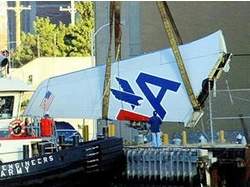NTSB Suspects Problems in Airbus 300 Series Airplanes
 The controversy continues over the airworthiness of the Airbus
300 series airplane's vertical stabilizer and rudder design. With
this concern specifically noted, the NTSB has issued Safety
Recommendation A-10-119 and -120 and Reiteration of NTSB Safety
Recommendation A-04-63.
The controversy continues over the airworthiness of the Airbus
300 series airplane's vertical stabilizer and rudder design. With
this concern specifically noted, the NTSB has issued Safety
Recommendation A-10-119 and -120 and Reiteration of NTSB Safety
Recommendation A-04-63.
While the NTSB brought up their findings in the November 12,
2001 crash of an Airbus A300-605R,1 N14053, operated as American
Airlines flight 587, they also specified concerns over another
incident... albeit one far less tragic. The NTSB specified that on
January 10, 2008, about 0848 central standard time, an Airbus
Industrie A319, Canadian registration C-GBHZ, operated as Air
Canada flight 190, experienced an in-flight upset after
encountering wake turbulence from a 747 while climbing from flight
level (FL) 360 to FL370.5 The flight crew declared an emergency and
diverted the flight to Calgary, where it landed uneventfully. Of
the 5 crewmembers and 83 passengers on board, 2 crewmembers and 8
passengers sustained minor injuries, and 3 passengers sustained
serious injuries. Visual meteorological conditions prevailed, and
an instrument flight rules flight plan was filed for the scheduled
domestic passenger flight from Victoria International Airport,
British Columbia, Canada, to Toronto Pearson International Airport,
Ontario, Canada. The Transportation Safety Board of Canada
investigated this accident; the NTSB and Bureau
d’Enquêtes et d’Analyses provided accredited
representatives and technical advisors to the investigation.
Data from the flight data recorder (FDR) indicate that, during
the upset, the airplane experienced several roll and vertical load
factor oscillations and lost about 1,000 feet of altitude. Although
the autopilot was engaged during the start of the wake vortex
encounter, after about 3 seconds, the autopilot was disengaged, and
there was a series of large oscillatory inputs on the left
side-stick controller.7 In addition, the FDR recorded a series of
three to four alternating rudder pedal inputs (right pedal, then
left pedal) over the next 15 seconds. During these inputs, the
airplane continued to oscillate in roll, reaching a maximum roll of
55º. At the same time, the recorded acceleration was also
oscillating, with peaks of -0.46 G to +0.49 G of lateral load
factor and peaks of -0.76 G to +1.57 G of vertical load factor.
Because of the severity of the upset, following the emergency
landing at Calgary, the airplane was grounded pending an inspection
by Airbus engineers. During an extensive inspection, the vertical
stabilizer was removed from the airplane and scanned ultrasonically
to inspect for damage to the stabilizer’s composite
components. No damage was found, and the stabilizer was reattached
and the airplane returned to service.
Although no damage to the stabilizer was found, an analysis of
the accident performed by Airbus indicated that the rear vertical
stabilizer attachment fitting sustained loads 29 percent above its
design limit load. Simulation work performed by Airbus revealed
that these high loads were primarily the result of the flight
crew’s series of alternating rudder pedal inputs and were not
the result of the wake turbulence. Information and animations
provided by Airbus showed that if the pilots had not made any
control inputs after the wake encounter, the airplane would have
righted itself with minimum altitude loss and g-loading.

Vertical Stab of AA587
Via these new documents, the National Transportation Safety
Board recommends that the European Aviation Safety Agency:
Modify European Aviation Safety Agency Certification
Specifications for Large Aeroplanes CS-25 to ensure safe handling
qualities in the yaw axis throughout the flight envelope, including
limits for rudder pedal sensitivity. (A-10-119)
After the yaw axis certification standard recommended in Safety
Recommendation A-10-119 has been established, review the designs of
existing airplanes to determine if they meet the standard. For
existing airplane designs that do not meet the standard, the
European Aviation Safety Agency (EASA) should determine if the
airplanes would be adequately protected from the adverse effects of
a potential aircraft-pilot coupling (APC) after rudder inputs at
all airspeeds. If adequate protection does not exist, EASA should
require modifications, as necessary, to provide the airplanes with
increased protection from the adverse effects of a potential APC
after rudder inputs at high airspeeds. (A-10-120)

Vertical Stab of AA587
In addition, the National Transportation Safety Board reiterates
the following recommendation to the European Aviation Safety
Agency:
Review the options for modifying the Airbus A300-600 and the
Airbus A310 to provide increased protection from potentially
hazardous rudder pedal inputs at high airspeeds and, on the basis
of this review, require modifications to the A300-600 and A310 to
provide increased protection from potentially hazardous rudder
pedal inputs at high airspeeds. (A-04-63)
 ANN's Daily Aero-Linx (04.13.24)
ANN's Daily Aero-Linx (04.13.24) ANN's Daily Aero-Term (04.13.24): Beyond Visual Line Of Sight (BVLOS)
ANN's Daily Aero-Term (04.13.24): Beyond Visual Line Of Sight (BVLOS) Airborne 04.09.24: SnF24!, Piper-DeltaHawk!, Fisher Update, Junkers
Airborne 04.09.24: SnF24!, Piper-DeltaHawk!, Fisher Update, Junkers Aero-News: Quote of the Day (04.14.24)
Aero-News: Quote of the Day (04.14.24) ANN's Daily Aero-Term (04.14.24): Maximum Authorized Altitude
ANN's Daily Aero-Term (04.14.24): Maximum Authorized Altitude





